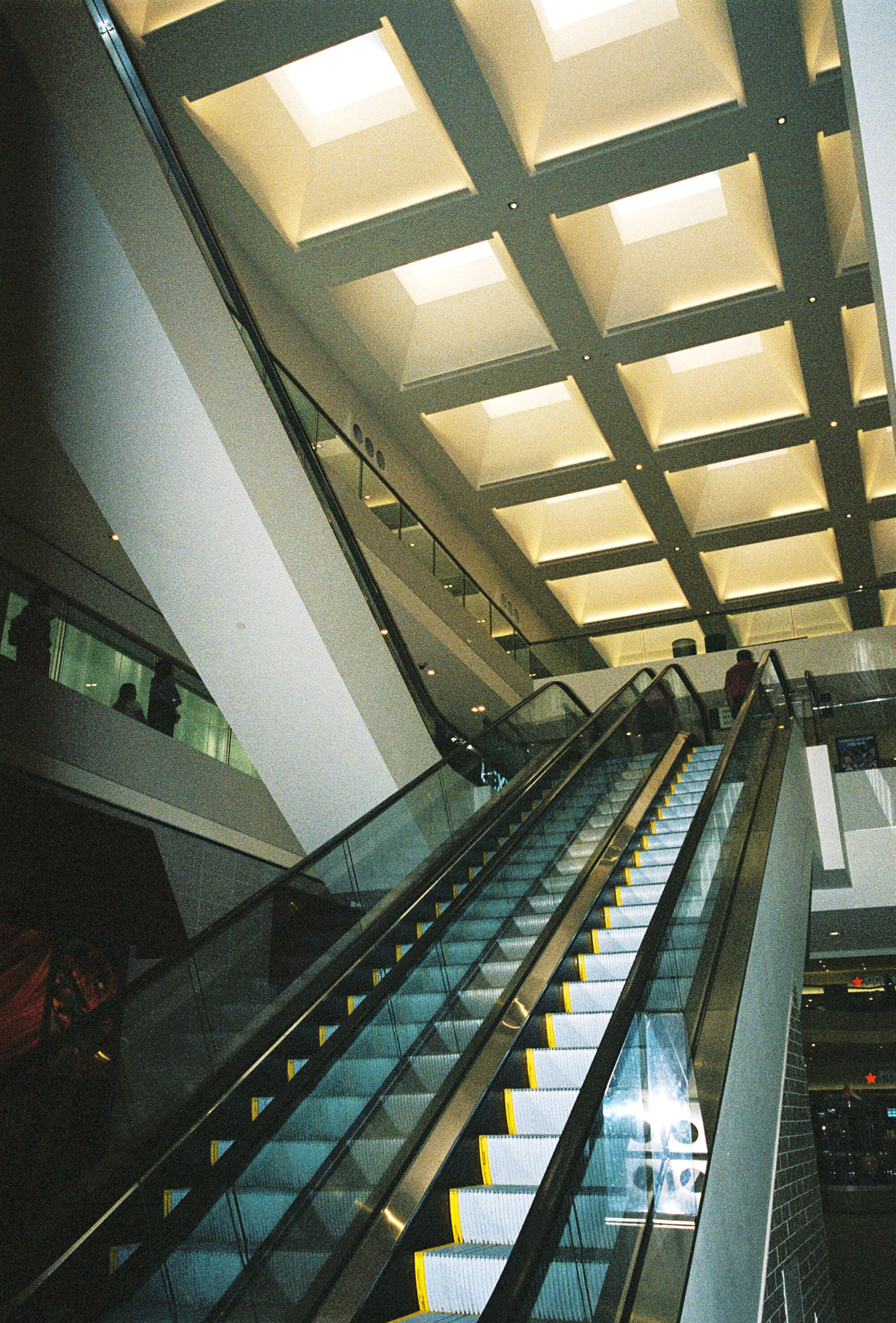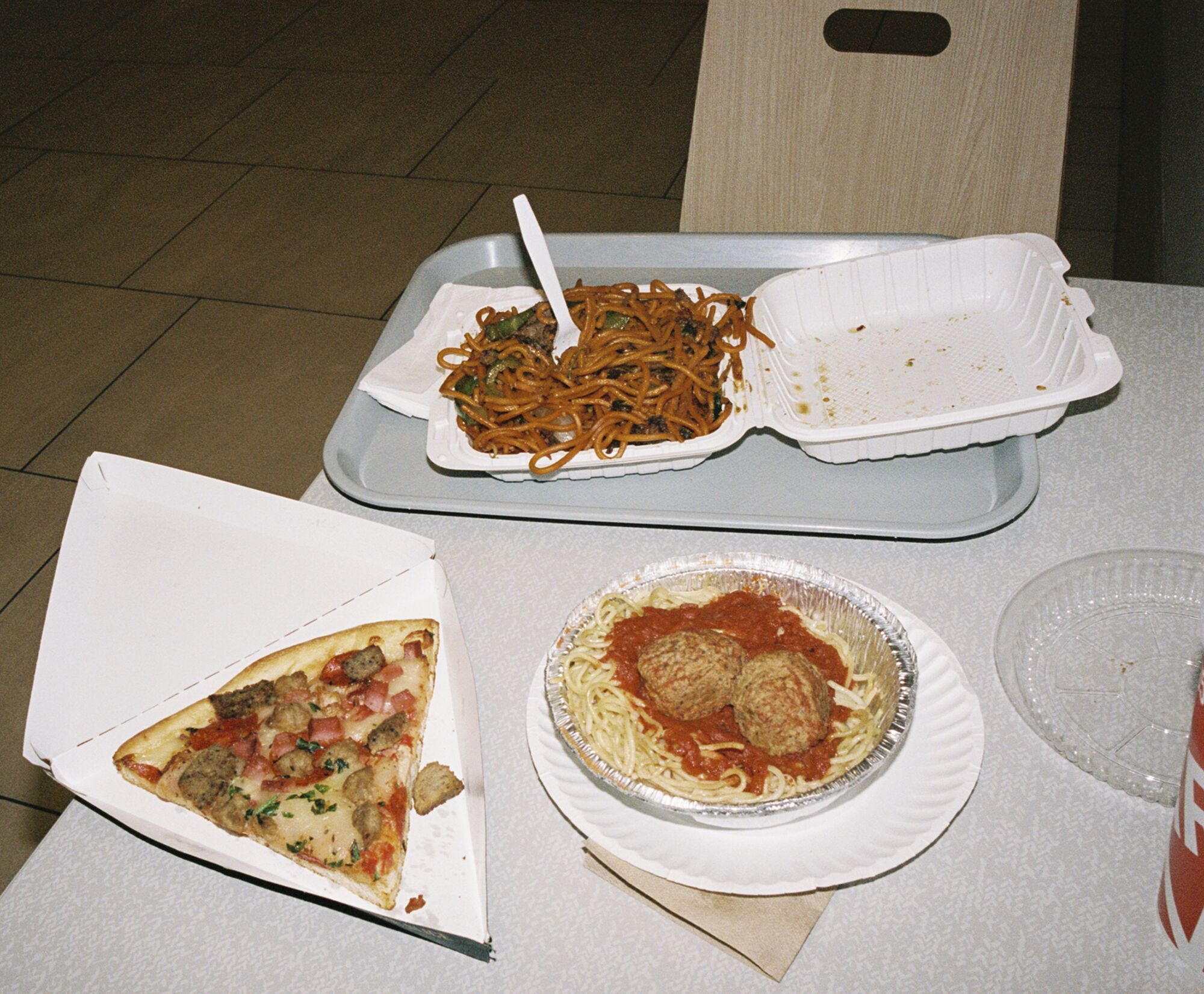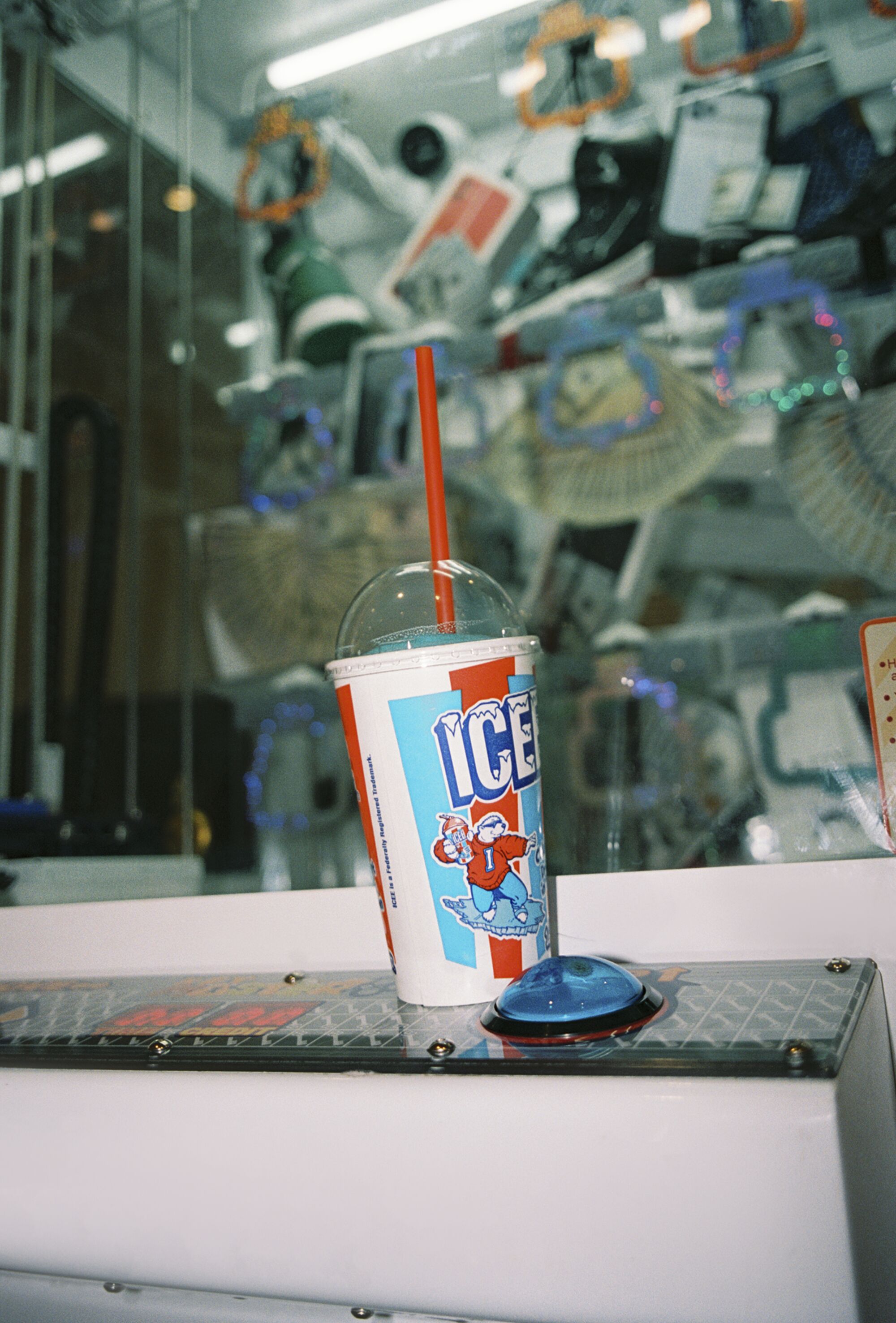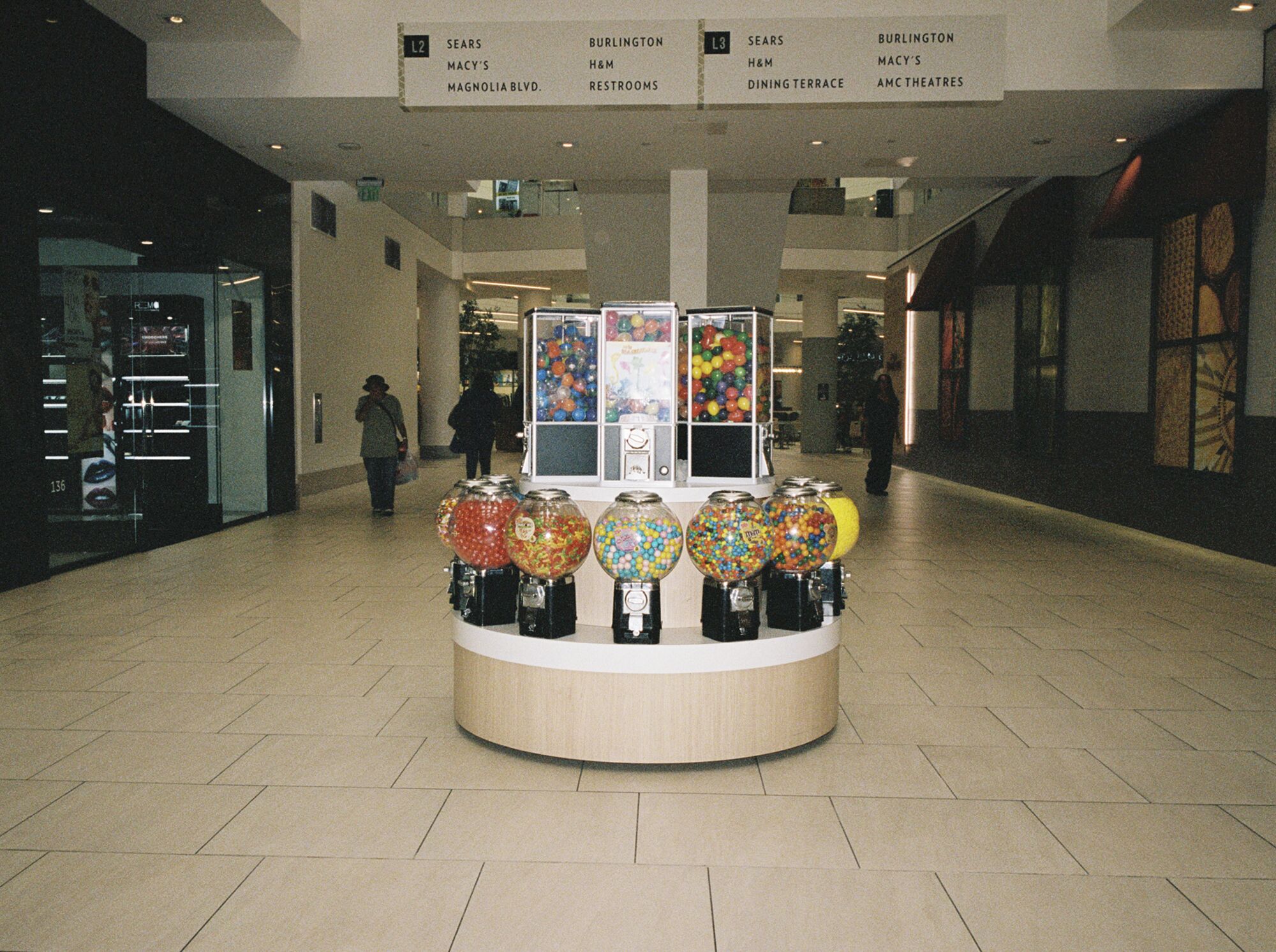The first real job I ever had, with a biweekly paycheck and taxes taken out, was at the Footaction in the Los Cerritos mall. For $5.75 an hour, I sold Nike Air Max 95s in gradient neon colorways, Iversons with the honeycomb air pods in the thick white soles, Adidas shell toes and classic shower slides in black, white, navy and baby pink. The store was in the same wing of the mall as the food court, and on my 30-minute lunch break, I had a choice of “international” cuisines: franchises like Sbarro (Italian), Hot Dog on a Stick (American) and Panda Express (Chinese), plus a Mongolian beef stir-fry place, a Japanese counter with teriyaki chicken bentos and California rolls, and a gyro shop, with the requisite poster of a smiling (presumably Greek) woman holding up the pita-wrapped treat. And for dessert, Auntie Anne’s cinnamon pretzel bites (um … German?); caramel dip was extra (definitely not German).
I’ll admit, the food court didn’t exactly offer any good, healthy meal options. Vegetables were an afterthought — if they were included at all in any of the combo specials. But when has the pleasure of eating ever been about nutritional value, anyway? Wearing my tidy sales associate uniform — a dark green collared shirt tucked into freshly ironed khakis (our store manager insisted on crease lines down the front of the pants), and a pair of supremely clean kicks, of course — I circled the food court like I owned the place. There was a tacit camaraderie among the retail and food service workers at the mall. I received courtesy nods and, sometimes, an extra egg roll or a free side of fries with my order. The food court was an oasis after spending hours on my feet, hustling back and forth between the stock room and the sales floor. Here I could finally relax my face, let go of the performative smile I learned to put on as soon as I started my shift.

“I loved dining at the food court. I loved the people-watching. I loved the ambient din of conversation,” writes Jean Chen Ho.
(Angella Choe/For The Times)
This was in the late ’90s, and I was back home after freshman year at Cal, living at my parents’ house for the summer. The soundtrack that played from the store speakers on mind-melting repeat featured Destiny’s Child (before Michelle joined up) and Naughty by Nature. I didn’t have a cellphone yet, but I wanted one, envious of friends who already had their very own Nokias attached to a family mobile plan. My parents paid my tuition, but a luxury item like a cellphone? I knew better than to ask. Hence the job at Footaction. I had a plan to start off my sophomore year right: with the ability to play Snake on a tiny screen.
I didn’t expect it to be so hard to save up my paycheck, though. Somehow most of the money I earned went right back into the Footaction cash registers. I only needed one pair of sneakers bought at the store to meet uniform standards. But incentivized by the employee discount and early access to the latest drops, my collection of running, basketball and skate shoes grew. I was a minimum-wage worker, trapped in a cycle of consumption. The food court was a part of this iniquitous setup. Sure I could’ve packed a sandwich — there was a mini-fridge in the back — but it was simply more convenient to buy lunch at the mall once I got to work.
Besides, I loved dining at the food court. I loved the people-watching. I loved the ambient din of conversation, the scrape of chair legs on the linoleum floor as people got up to toss their trash and stack their trays. The food court was a comforting place to disappear. Back home in my high school bedroom again, I felt not so different than I had a year ago, despite all that I’d seen and experienced in my first year of college, living in the dorms. I was still an undeclared major, uncertain about where my scholastic future led. At the end of August, I’d move into my first apartment, shared with two friends. I’d learn to make Ichiban ramen and beef stroganoff Hamburger Helper. But for now, for the summer, I ate what my mom cooked at home and I ate at the food court when I was at work.
🥨🥨🥨
In high school, the food court was a portal to a world of exotic possibilities, far beyond the reaches of my staid Taiwanese American life in Southern California. I’d always found friends easily; but as a teenager, I still sometimes felt an existential loneliness. Maybe it had to do with being an only child, or the fact that I was an introvert who devoured library books I didn’t always fully understand. Or maybe it was that I’d spent the first eight years of life in a bustling urban environment surrounded by lots of family in Taipei, to then move to the U.S. with only my parents, who fought constantly. First to an extremely white, rural college town in Missouri, then to a wildly disparate Southern California suburb three years later, where I met kids who lived in gated communities with pools — pools! — in their backyards. I was acutely aware of how much less my family seemed to have than the new friends I made in Cerritos.
Or maybe it didn’t have anything to do with any of that. I don’t know. Growing up, my family rarely ate out, and if we ever did, it was definitely at a Chinese restaurant, one of those places with a fish tank in front. The food court at the mall, where I sometimes ended up on the weekend with my friends, was where I first felt like I had real choices in what I might eat. Despite the inauthenticity of its supposed global fare, the “international” aspect of the mall food court felt to me like an important distinction, setting it apart from what was offered at the school cafeteria.

“In high school, the food court was a portal to a world of exotic possibilities,” writes Jean Chen Ho.
(Angella Choe/For The Times)
On any given Saturday, my girls and I would find our way to the mall. We performed a version of what Virginia Woolf describes so beautifully in “Street Haunting” (an essay I wouldn’t discover until many years later): the subversive joy of strolling aimlessly. “With no thought of buying, the eye is sportive and generous; it creates; it adorns; it enhances,” Woolf writes. Similarly, my friends and I would let our eyes and imaginations roam, alighting at this place or that to admire something beautiful to our teenage sensibilities. We sprayed the insides of our wrists with Issey Miyake perfume at the department store makeup counter, ran our fingers over the plush piles of cashmere sweaters on display near the door, then made our way to Judy’s or Contempo Casuals to try on baby tees and slip dresses. No intention of buying a single thing.
Woolf’s essay, published in the interwar years of the early 20th century, was an ode to walking outdoors on a brisk winter evening in London. We were Asian American young adults in California on the cusp of the new millennium, swanning around the corridors of a temperature-controlled indoor shopping center, though no less susceptible to the “champagne brightness of the air” in our particular environment, in our specific time. Woolf ends up at a stationery shop on the Strand, where she purchases a single lead pencil before heading home. As for me and my coterie of teenage girl flaneurs, we sashayed toward the food court.
🍕🍕🍕
Though originally designed as a place for shoppers to rest and refuel between purchasing sprees, the mall food court took on a wholly different meaning for people like me, who came of age at the cusp of the late ’90s and early 2000s. It was our public square, a meetup spot to take a beat and check for any cute guys around or assess our competition in other groups of girls out and about like us. It was where we lingered — when does lingering pass into loitering? — hoping for something exciting and spontaneous to happen to us. Wasn’t it possible that one of us might be discovered by a talent scout who was looking for the next Jenny Shimizu or … well, that was the only famous Asian model we knew of, but still. Couldn’t it happen?
We settled into one of the plastic tables and matching chairs. I ordered and ate whatever I wanted, accompanied by a 22-ounce fountain drink. This freedom of choice tasted delicious. And over our Styrofoam containers, my friends and I talked. We discussed our plans for the upcoming winter formal, or some flier party a friend’s older cousin was DJing at next weekend. We complained about our parents, that favorite pastime of beleaguered teenagers everywhere. We daydreamed out loud about who we wanted to become, how we’d get there, and what we’d be wearing when we arrived. Or, I should say, mostly it was my friends who talked; I listened. And I kept these stories in mind for a long time after.

“The food court was a comforting place to disappear,” writes Jean Chen Ho.
(Angella Choe/For The Times)
Many years later, when I began to write fiction, these memories came to me, unbidden. I was in my early 30s and pursuing an MFA in creative writing in Las Vegas. There were nights I walked through casino floors on the Strip or downtown, with no intention of gambling or otherwise spending any money. Whatever stories I may have heard or helped to make up in the mall food court as a lonely teenager — about the shoppers and fellow mall employees there, about my friends and myself — found an echoing resonance under the brilliant lights of the casino compound, those uniquely windowless arenas in Vegas that feature buffets, luxury retail shops, bars and nightclubs, resort pools and spas, movie theaters, bowling alleys and live performance venues, all of it a never-ending hedonistic spectacle. Eventually I came to see many of these surreal, consumer-centered spaces the way I saw the mall food court in my youth: a place to disappear into the crowd, to quietly observe people interacting in a place with a highly specific aim — spend money and have the most fun doing it — and to notice those who were having some other experience, moving in a counter-direction. Someone like me, perhaps, who went there to disappear too.
🍝🍝🍝
Somewhere in the last decade, the familiar and comforting food courts of my ’90s youth seem to have disappeared from the cultural imagination, if not entirely from the actual retail landscape. The enclosed multilevel mall now signals a bygone era and inspires a sense of vintage nostalgia. These days, outdoor shopping centers with open-air walkways that mimic a sanitized, stylized version of urban thoroughfares are trending. Across the U.S., these types of outdoor malls have tripled in number since 2004, while zero enclosed malls have opened since 2007. Andres Sevtsuk, an urban planning associate professor at MIT, emphasizes, however, that while these “lifestyle centers” borrow from urban retail aesthetics, they occupy a vastly different socioeconomic space, with an exclusive focus on wealthy clientele. “While most Main Streets tend to offer genuinely diverse shops and eateries for different income levels, lifestyle centers are packed with upscale establishments, with little offered for low-income households,” he writes in “Street Commerce: Creating Vibrant Urban Sidewalks.” Within these shiny new malls, the humble food court of yore has been made over as the “food hall.”
While I appreciate the organic ingredients and vegetarian-friendly options — culinary elements that rarely existed in older, traditional food courts — food halls don’t seem to allow for the pleasure of serendipity that Woolf took such delight in on her rambling walks through town, similarly enacted by the teen version of my friends and me years ago. Gourmet food halls, with their attendant specialty markets, aren’t a communal space for young people to test out their desires for independence. Rather, they offer a set menu for affluent adults to consume. The food hall is now a destination unto itself, as if a specialized mall within the mall. Designed with a familiar aesthetic that signals a chic, cosmopolitan urbanity (subway tiles and exposed brick walls, marble countertops and oak wood tables, Mexican coke in glass bottles and artisanal kombucha), today’s food hall lacks the democratic chaos of the food courts I used to frequent. But I guess that’s the point, right? Unlike the quotidian food court, whose aesthetics left room for us to use its space as we saw fit, food halls today are designed to attract a narrow set of customers.
It’s possible I’m romanticizing things; my sense of nostalgia coloring the way things were back then. The food court, like the rest of the mall, was still a space mostly set up for consumption, under surveillance. It was managed by a corporate real estate entity, policed by private security. Maybe teenagers and young people today have no need for places like the food court, the way I did, because they have many other avenues to connect with their friends. I know a woman with a 14-year-old son, and I recently asked if he ever hangs out at the mall, if he goes to the food court to meet up with his friends. She laughed and said no: “He stays home and plays videos games with them online.”
🍭🍭🍭
A couple months ago, I went to get my hair cut at a new salon in Koreatown. My hairstylist had moved to a space inside Koreatown Plaza, a mall that’s been around since the late ’80s and looks like it has never been renovated. I hadn’t stepped foot inside here since high school — a friend’s mother used to own a clothing store on the second level. Blush pink and mint green tiles form bold geometric patterns on all three stories of the mall, and polished brass guardrails protect the balconies. The atrium is filled with oversized beige planters, and a cylindrical glass elevator lowers dramatically into a bubbling fountain, lit by rings of globe bulbs.
On one end of the ground floor hallway, a bright red neon sign announced the entrance to the mall’s International Food Court. I didn’t realize I’d been missing it until I was standing there, knocked over by nostalgia. This was no high-concept “food hall.” It was a simple food court — a clean, welcoming place. There were a dozen food stalls here, mostly different Korean cuisines (soy garlic wings and other fried treats on sticks, a dumpling station, blood sausage and kimchi jjigae), and other Asian offerings too: pho, sushi, tonkatsu. The smell that hung in the air was a mixture of soybean paste, fish sauce, sesame oil. Walking a circle around the food court, studying my food choices, I heard English, Korean, Spanish and Tagalog. The only “American” food was the Philly cheesesteak stand in the corner.
Here before me was the kind of food court I’d slowly lost sight of in the last twenty years. Next to the glass door entrance, there was a mural one might find in an elementary school classroom. A bullfrog and a corgi puppy in a field of daffodils look toward the painted boy acrobat who hangs upside down from his rings, surrounded by butterflies and bumblebees. The center section of the food court’s ceiling was lit up by panels of soft white light that mimicked the sun in midday, creating a sense of perpetual morning. And yet, the neon signs at every vendor stall evoked a sense of night, suggestive of the street food markets open late into the evenings in Asia. Flat panel TV screens were mounted on pillars, showing a hockey game and the local news. The haphazard juxtaposition of the mural, contrasting lighting schematic, and giant TVs all filled me with a sense of comfort. The style aesthetic in the Koreatown Plaza food court was decidedly anti-style; this food court had something for everyone.

“The comforting food courts of my ’90s youth seem to have disappeared from the cultural imagination,” writes Jean Chen Ho.
(Angella Choe/For The Times)
I ordered my meal and sat down to wait for the buzzer to alert me it’s ready to be picked up. Glancing around, I saw families eating together, toddlers buckled into strollers and highchairs. A group of teenagers huddled together at a nearby table, holding up their phones to share something every so often. A foursome of women in their 60s sat chatting over their metal soup noodle bowls. Three men in work uniforms and orange vests dug into their rice and KBBQ plates.
Then it dawned on me: Did I just discover a new workspace to write, with excellent food options and ample parking besides? I was no longer the harried retail worker seeking a small moment of peace on her lunch break, or the teenage girl who occupied the food court for hours with her friends, learning how to take up space in the world. As a writer who lives alone and works mostly from home, I’d been considering the appeal of joining a co-working space lately, after the last couple years of increased social isolation. Why not come here to write? Ah, the food court still provides.
Jean Chen Ho is a writer in Los Angeles and a doctoral candidate in creative writing and literature at USC, where she is a Dornsife fellow in fiction. She has a master of fine arts from the University of Nevada, Las Vegas. She was born in Taiwan and grew up in Southern California. Her first book, “Fiona and Jane,” a collection of linked stories, is out from Viking. @jeanho66

